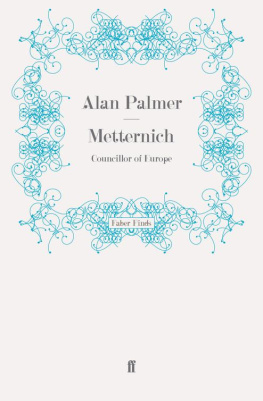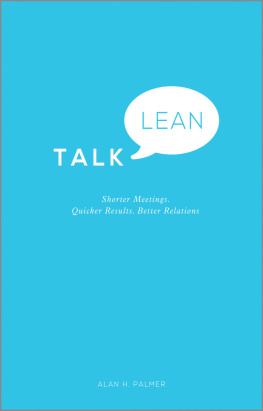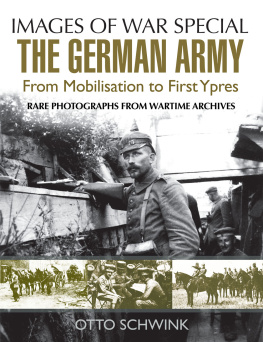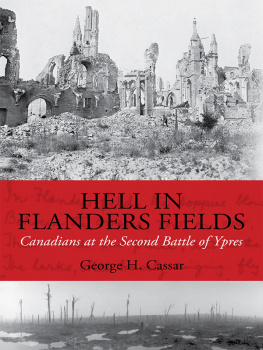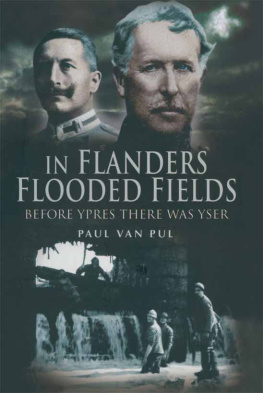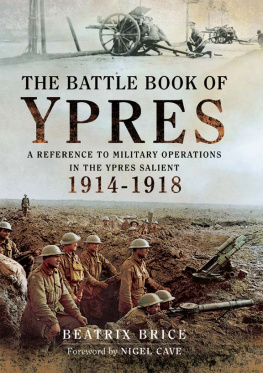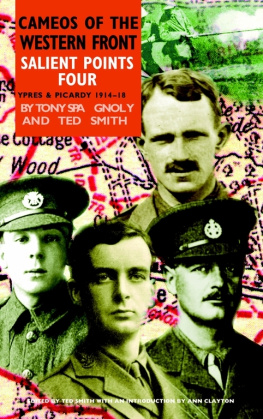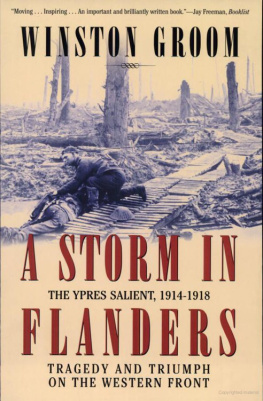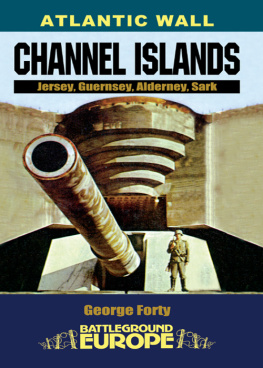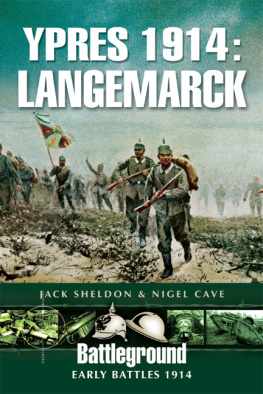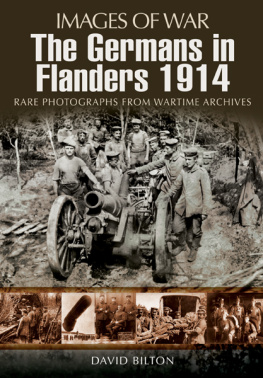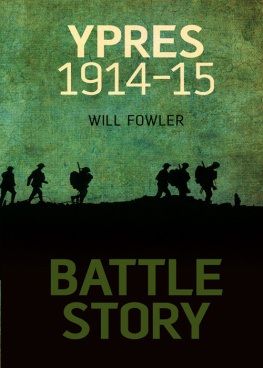The SALIENT
The SALIENT
YPRES, 1914 18
ALAN PALMER
CONSTABLE LONDON
To Charmian and Christopher Johnson
in gratitude and with deep affection
Constable & Robinson Ltd
5556 Russell Square
London WC1B 4HP
www.constablerobinson.com
First published in the UK by Constable,
an imprint of Constable & Robinson Ltd, 2007
Copyright Alan Palmer 2007
The right of Alan Palmer to be identified as the author of this work has been asserted by him in accordance with the Copyright, Designs and Patents Act, 1988.
All rights reserved. This book is sold subject to the condition that it shall not, by way of trade or otherwise, be lent, re-sold, hired out or otherwise circulated in any form of binding or cover other than that in which it is published and without a similar condition being imposed on the subsequent purchaser.
A copy of the British Library Cataloguing in
Publication Data is available from the British Library.
ISBN: 978-1-84119-633-6
eISBN: 978-1-4721-1278-1
Printed and bound in the EU
1 3 5 7 9 10 8 6 4 2
Jacket image: detail of The Ypres Salient at Night by Paul Nash, Imperial War Museum;
Design: Bob Eames
CONTENTS
LIST OF ILLUSTRATIONS
(Negative Q. 57189 courtesy of the Imperial War Museum, London)
(Negative Q. 60737 courtesy of the Imperial War Museum, London)
(Negative Q. 57328 courtesy of the Imperial War Museum, London)
(Negative HU35801 courtesy of the Imperial War Museum, London)
(Negative Q. 51067 courtesy of the Imperial War Museum, London)
(Negative Q. 2315 courtesy of the Imperial War Museum, London)
(Negative Q. 5935 courtesy of the Imperial War Museum, London)
(Negative Q. 23728 courtesy of the Imperial War Museum, London)
(Negative E (AUS). 1171 courtesy of the Imperial War Museum, London)
(Negative E (AUS). 1205 courtesy of the Imperial War Museum, London)
(Negative Q. 23665 courtesy of the Imperial War Museum, London)
(Photograph taken by Christopher Johnson)
ACKNOWLEDGEMENTS
It is a pleasure to acknowledge the help I received from many different sources during the years spent writing The Salient. I am grateful to the staffs of the London Library, the Bodleian Library and the Oxfordshire County Libraries for their ready assistance. Sir Martin Gilbert a friend ever since I had the good fortune to teach him in the Highgate School sixth form shared with me some of his deep knowledge of both world wars. Dr Christopher Dowling, another one-time pupil, and his wife, Angela Godwin, welcomed me to the Imperial War Museum, where I also benefited from the guidance of Hilary Roberts of the photographic archive. Clare and Robert Brown encouraged me, as so often in recent years. On particular points, I am indebted to my niece Catherine Clarke and to Marsali Dening, whose father served with the Australian 14th Infantry Battalion. I much appreciate the loan of material from Michael Millard, including his fathers unpublished recollections of Nieuport Bains before 1914 and of Third Ypres. At Ieper, Genevra Charnley was an informative guide to modern developments, and I thank the management and staff of the Ariane Hotel for their help and solicitude during my recent visits.
Anyone reading the reference notes and bibliography will realize the heavy debt I owe to the many detailed studies published in the last quarter of a century as well as to earlier official histories and memoirs. As it has proved impossible to trace all copyright holders, the author and publisher apologize to those whom they have not been able to contact. Every effort will be made in any future edition to rectify previous omissions. Max Arthurs Forgotten Voices of the Great War and Lyn Macdonalds 1914 and her 19141918: Voices and Images of the Great War have been of particular value. So, too, were the many works written or edited by Malcolm Brown of the Imperial War Museum. He also wrote an informative introduction to the highly entertaining facsimile edition of The Wipers Times published by Little Books Ltd in 2006. Ian Becketts invaluable Ypres: The First Battle, 1914 includes the vivid letter by Captain (later Lieutenant-Colonel) Dillon (on pp. 689) from the Imperial War Museum archive. Gary Sheffield and John Bournes edition of The Haig Diaries supplements Robert Blakes no less valuable earlier collection of Haigs private papers. Herbert Sulzbachs With the German Guns is a particularly stimulating personal narrative of a young German officers experience. The Battleground Europe series published by Leo Cooper always made rewarding reading, especially Peter Oldhams Messines Ridge and Nigel Caves Sanctuary Wood and Hooge as well as his summaries of Passchendaele, Polygon Wood and Hill 60. Peter Liddles compendium Passchendaele in Perspective includes several contributions from which, as the reference notes show, I have profited greatly. Gavin Roynons edition of the Crofton diaries, Massacre of the Innocents, is particularly attractive and well produced. Major and Mrs Holts The Ypres Salient remains indispensable. It is far more than a guidebook.
Constable and Robinson have shown great patience in awaiting completion of a book delayed for two years by health problems and I much appreciate their understanding. With gratitude I recall the enthusiasm Carol OBrien showed for the project when it was first mooted. Subsequently, I have benefited from the refreshing suggestions and eagle eye of my copy editor, Helen Armitage, as well as from Claudia Dyers guidance at Constable and Robinson.
The Salient could not have been written without the support I received from Christopher Johnson and his wife, Charmian Hearne. I have enjoyed their hospitality and the fun of their young family time and time again. Christopher has been my computer mentor and, to my delight, found time to drive me to Ieper in 2001, 2005 and 2006 for research visits, his camera and notebook at the ready. With great pleasure I dedicate this book to them both.
Alan Palmer, February 2007
AUTHORS NOTE
In rendering measurements of distance and weight I have followed practices common during the First World War. Distances therefore appear in yards and miles. Readers accustomed to thinking metrically may find it useful to refer to the table featured below. Measurements of volume and weight are given as metric for German and French guns and shells i.e. Frances famous 75 mm field gun but in traditional imperial units for British weapons i.e. the British 18-pounder field gun.
Imperial | Metric |
Distance | 1 inch | 25.4mm |
1 foot (12 inches) | 304.8mm |
1 yard (3 feet) | 0.9 metres |
10 yards | 9.1 metres |
100 yards | 91.4 metres |
1 mile (1,760 yards) | 1.6 km |
10 miles | 16.1 km |
100 miles | 160.9 km |
500 miles | 804.6 km |
Weight | 1 lb | 0.5 kg |
1 stone (14 lb) | 6.3 kg |
Alternative Place Names
Place names are shown as they appear on the official war office maps. Many names in modern guidebooks and on all signposts are in Flemish. Ypres, for example, is now known as Ieper. A list of alternative place names is therefore printed here.
Next page



